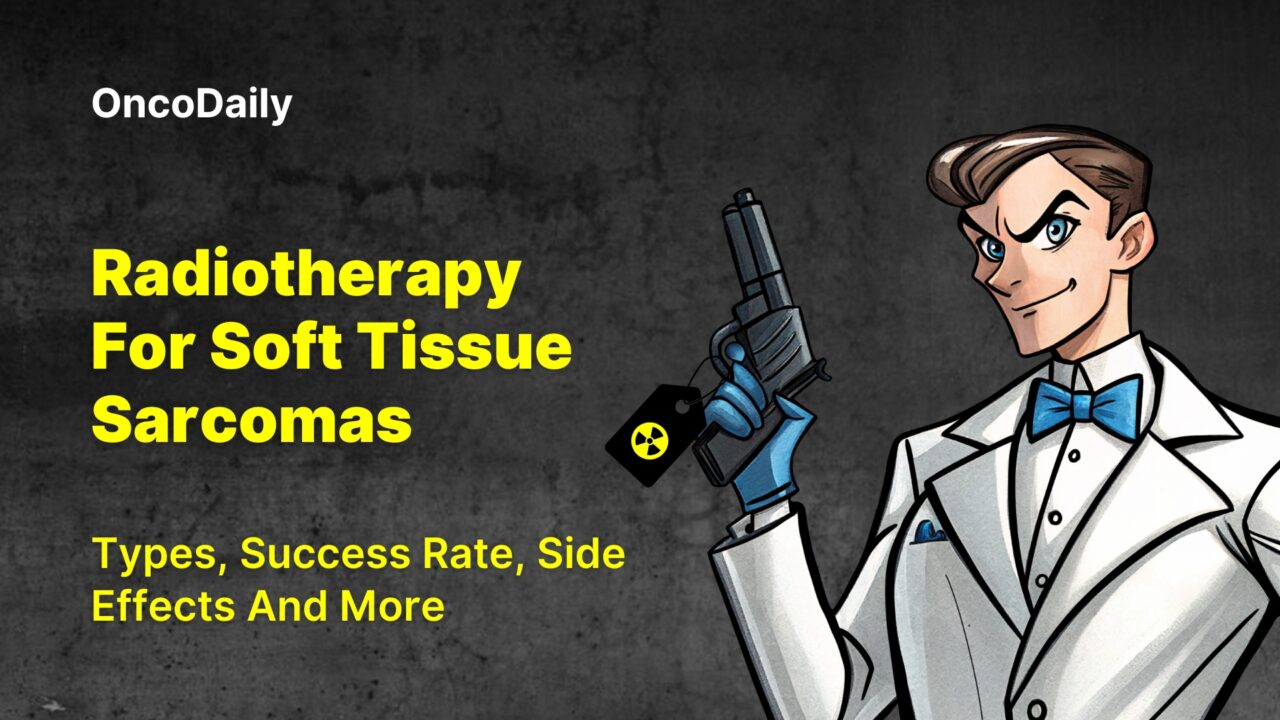
Radiotherapy For Soft Tissue Sarcomas: Types, Success Rate, Side Effects And More
Radiotherapy for soft tissue sarcomas is a fundamental treatment that uses high-energy rays or particles to destroy cancer cells. It is commonly integrated with surgery, being administered either before an operation to shrink the tumor or afterward to eliminate any remaining cancer cells and lower the chance of local recurrence. This therapy is also utilized as a primary treatment for tumors that cannot be removed surgically, for limited spread of the disease, or to help manage symptoms, often employing advanced techniques for precise targeting to protect surrounding healthy tissues.
What is Radiotherapy and How It Works?
Radiotherapy is a form of cancer treatment that employs high-energy sources, such as X-rays or other particles, to destroy cancer cells. It works by delivering these potent rays or particles to the target and eliminating the malignant cells. Some advanced methods involve focusing these doses intensely on the tumor volume, which allows for high biologically effective doses to effectively kill the cancer cells while potentially reducing harm to surrounding healthy tissues.
Types of Radiotherapy for Soft Tissue Sarcomas
Radiotherapy for soft tissue sarcomas is delivered using various techniques, each with specific characteristics aimed at effectively targeting cancer cells while minimizing the impact on healthy tissues. The choice of method often depends on factors like the tumor’s location and size.
External beam radiation therapy (EBRT)
External beam radiation therapy is described as the most commonly used type, where radiation is delivered from a machine outside the body. This approach can be traditional or involve more advanced methods like intensity-modulated radiation therapy (IMRT), which uses sophisticated computer guidance for more precise radiation delivery, or image-guided radiotherapy (IGRT), which is used for accurate daily patient and tumor positioning. It is applied in various scenarios, including before or after surgery, as a primary treatment, or for symptom relief.
Brachytherapy
Brachytherapy, also known as internal radiation therapy, involves placing small radioactive sources, such as pellets or seeds, directly into or very close to the cancer. These are often inserted through thin tubes placed during surgery. This technique can be used alone or combined with external beam radiation and is sometimes employed as a boost to increase the dose to a specific area or in treating recurrent tumors, offering the potential benefit of limiting the volume of healthy tissue irradiated.
Stereotactic body radiation therapy (SBRT)
Stereotactic body radiation therapy (SBRT), also referred to as stereotactic radiotherapy (SRT) or radiosurgery (SRS), is a technique that delivers highly focused and intense doses of radiation over a small number of treatment sessions. This method utilizes sophisticated image guidance to pinpoint the tumor’s exact location, allowing for exact delivery of radiation to cancer cells and minimizing damage to surrounding healthy tissue. It is considered for treating unresectable primary tumors, limited metastatic sites in organs like the lung, bone, or brain, and for palliative purposes.
Proton Therapy
Proton therapy, or proton beam radiation, uses streams of protons or special particles instead of high-energy X-rays. According to one text, these particles can be focused on the tumor. They may not penetrate beyond it, which can reduce the likelihood of side effects by limiting damage to nearby healthy tissues. This unique characteristic potentially allows doctors to deliver a higher radiation dose specifically to the tumor.
While it is noted to have theoretical advantages over some other techniques and offers unique dosimetric benefits that may allow for dose escalation with less toxicity, one text mentions it has not been proven to be a better treatment for soft tissue sarcoma and is not widely available. Particle therapy, including protons, is also considered for reirradiation due to its ability to limit dose to surrounding tissues.
How Effective is Radiotherapy for Soft Tissue Sarcomas?
Definitive radiotherapy for unresectable soft-tissue sarcomas shows efficacy in selected patients. A study by Allignet et al. (Radiotherapy and Oncology, 2022) of 116 patients reported 3-year overall survival of 34% and a median OS of 21.4 months, with a 3-year local failure rate of 43.2% after modern RT. Grade 3 tumors and T3-T4 stage negatively impacted survival, while higher RT dose (EQD2 ≥ 64 Gy) and incomplete resection were linked to better OS. The treatment was deemed safe, with low rates of severe adverse events.
Preoperative hypofractionated radiotherapy (HFRT) for soft tissue sarcomas appears promising. A systematic review by Roohani et al. (Radiation Oncology, 2022) analyzed 13 studies (8 phase II, 5 retrospective). Results suggest HFRT does not increase adverse events and shows comparable or lower toxicity and similar local control rates compared to historical normofractionated RT, but with shorter treatment duration. Further data from ongoing prospective trials are awaited.
What Are the Side Effects of Radiotherapy for Soft Tissue Sarcomas?
Radiotherapy for soft tissue sarcomas can lead to various side effects, with the specific effects depending on factors such as the area of the body being treated and the radiation dose administered. These effects can be broadly categorized based on when they occur.
Short Term Effects
Short-term or acute effects typically occur during or shortly after radiation therapy. Common acute side effects include changes to the skin where the radiation passes through, which can manifest as redness, blistering, or peeling. Patients may also experience fatigue. If radiation is delivered to the abdominal or pelvic areas, nausea, vomiting, or diarrhea are more common, while treatment to the head, neck, or chest might cause pain with swallowing. If radiation is given before surgery, it may lead to problems with wound healing or increase the risk of wound complications following the operation. Some studies mentioned acute toxicities like low white blood cell counts or skin inflammation.
Long Term Effects
Long-term or late effects can develop months or even years after radiation treatment has concluded. According to the texts, bone weakness is a potential late effect that could result in fractures or breaks later on. Radiation to the chest area can sometimes lead to lung damage, causing breathing problems, and these issues, along with bone weakness, may be permanent. Treating large sections of an arm or leg can result in long-term swelling, pain, and weakness in the affected limb.
If radiation is administered after surgery, long-term stiffness and swelling that impact the limb’s function can occur. Other late toxicities noted include fibrosis, edema, and joint stiffness. Radiation to the brain for metastatic disease was associated with potential permanent hair loss, headaches, and thinking difficulties. Serious long-term complications, such as soft-tissue necrosis or bowel obstruction, have been reported, and there is a noted risk of amputation due to complications in some cases, particularly with reirradiation.
How is Radiotherapy for Soft Tissue Sarcomas Administered?
The administration of radiotherapy for soft tissue sarcomas involves a meticulous planning process by a dedicated team of experts. This planning is crucial to effectively treat the cancer while minimizing harm to healthy tissues and organs near the tumor. The process includes defining specific target volumes for radiation delivery. Typically, this involves outlining the visible tumor or the area where the cancer was surgically removed using imaging like contrast-enhanced MRI.
A safety margin is added around this area to create the clinical target volume, intended to cover any potential microscopic spread of disease. However, this margin can be adjusted at anatomical boundaries. An additional margin is included to form the planning target volume, accounting for daily setup variations. Planning also involves imaging techniques, potentially including those that account for movement like breathing, and often incorporates daily image guidance to ensure accurate positioning and potentially allow for smaller treatment volumes. Careful attention is paid during planning to limit the dose delivered to sensitive structures and organs at risk, for instance, by sparing certain areas like a strip of skin to help prevent side effects such as swelling.
How Long Does It Take to See Results?
The time it takes to see results from radiotherapy for soft tissue sarcomas can vary depending on the intended outcome of the treatment. For instance, when radiation is used before surgery to shrink the tumor, this effect would be observed in the period leading up to the operation. If the goal is to alleviate symptoms of advanced disease, relief such as pain reduction might be noticed relatively sooner, sometimes within a few weeks or months.
However, results related to controlling the cancer locally and preventing it from returning are typically evaluated over much longer periods. Studies often report outcomes like local control or recurrence-free survival measured at specific time points, such as one, two, three, or five years after the completion of therapy.

Read OncoDaily’s Special Article About the Role of Radiation Oncologists
What Are the Costs of Radiotherapy for Soft Tissue Sarcomas?
Several factors influence the cost. The specific type of radiation technique used plays a major role; for example, advanced techniques like proton therapy are often more expensive than standard external beam radiation therapy. The total number of treatment sessions required also impacts the overall cost, as does the complexity of the treatment plan and the technology involved. Where the treatment is administered, such as whether it’s in a hospital or a standalone clinic, can also affect the price. Furthermore, the tumor’s characteristics, its size, and location can influence the complexity and duration of treatment, thereby affecting costs.
Beyond the direct treatment expenses, there can be additional costs such as imaging for planning, potential hospital stays, managing side effects, and non-medical costs like transportation and lost income. Insurance coverage and a patient’s specific plan benefits also significantly determine their out-of-pocket expenses. Because of these many variables, providing a single specific cost is difficult, as it is highly individualized.
Where Are The Recent Advancements in Radiotherapy for Soft Tissue Sarcomas?
Bryant et al. (2024) published in Radiotherapy and Oncology reported the HARD regimen for unresected STS showed excellent local control (96.4% 3-year LC vs 48.4% with standard fractionation, p < 0.001). HARD improved local control compared to standard fractionation and was safe, not associated with an increase in toxicity.
Cury et al. (2024) published in Radiotherapy and Oncology conducted a meta-analysis showing 5-day preoperative RT for sarcomas resulted in high local control (92.3%) and R0 margins (84.5%), with acceptable wound complication rates (30%). Higher BED regimens were associated with better LC and R0 margins. This ultra-hypofractionated approach is recommended for experienced centers only.
How Can Patients Support Their Health During Radiotherapy?
It is crucial for patients to discuss all these aspects and any concerns with their healthcare team, as they can provide personalized advice based on the individual’s situation and treatment plan.
Physical Well-being and Side Effect Management
Supporting physical health during radiotherapy involves managing the side effects that may arise. Fatigue is a common side effect, and while it’s important to rest when needed, staying as active as possible with gentle, approved exercises can sometimes help manage energy levels and maintain physical function. Skin in the treatment area requires careful attention, often involving following specific instructions from the care team on cleaning and using lotions or creams to soothe irritation and prevent complications. Addressing other physical side effects promptly with the healthcare team is also key to maintaining comfort and well-being throughout the treatment course.
Nutrition and Hydration
Maintaining good nutrition and staying well-hydrated is vital during radiotherapy. Treatment can sometimes affect appetite, taste, or digestion, depending on the area being treated, potentially leading to weight loss or nutritional deficiencies. Eating a balanced diet and trying to consume enough calories and protein is important for maintaining strength and supporting the body’s ability to heal. Staying hydrated by drinking plenty of fluids is also essential, particularly if experiencing side effects like diarrhea or nausea. A dietitian on the care team can provide tailored dietary recommendations.
Mental and Emotional Health
Radiotherapy, like other cancer treatments, can have a significant impact on a patient’s mental and emotional health. Feelings of stress, anxiety, fear, or sadness are common. It is important for patients to acknowledge these feelings and seek support. Talking with family, friends, or support groups can be beneficial. Mental health professionals or counselors specializing in cancer support can also provide strategies for coping with the emotional challenges of treatment. Practicing relaxation techniques, mindfulness, or engaging in enjoyable activities can also help manage stress and improve overall emotional well-being.
Written by Aren Karapetyan, MD
FAQ
What is radiotherapy for soft tissue sarcomas?
Radiotherapy is a type of cancer treatment that uses high-energy rays or particles to destroy sarcoma cells.
How does radiotherapy work?
It works by delivering potent energy aimed at killing cancer cells, often using techniques that allow for precise targeting to minimize damage to surrounding healthy tissues.
Is radiotherapy always used with surgery?
While commonly used alongside surgery either before or after the procedure, radiotherapy can also serve as the primary treatment in specific situations where surgery isn't feasible, or for palliative care to manage symptoms
What are some different types of radiation therapy techniques used?
Several techniques are used, including External Beam Radiation Therapy (often with IMRT and IGRT), Stereotactic Body Radiation Therapy (SBRT), Proton Therapy (or particle therapy), Intraoperative Radiation Therapy (IORT), and Brachytherapy (internal radiation).
Why might radiotherapy be given before surgery?
Giving radiation before surgery, known as neoadjuvant therapy, can help shrink the tumor, potentially making it easier for the surgeon to remove it and sometimes allowing for a smaller operation.
What are common short-term side effects?
Common effects that occur during or shortly after treatment include changes to the skin in the treated area, feelings of fatigue, and potentially nausea, vomiting, or diarrhea depending on which part of the body receives radiation.
What are potential long-term side effects?
Possible effects that may develop later include weakening of bones, which can lead to fractures, damage to organs like the lungs if treated in that area, persistent swelling, stiffness, or pain in a limb, and the development of fibrosis.
How long does it take to see the effects of radiotherapy?
The timing varies; tumor shrinkage may be observed before planned surgery, symptom relief for palliative treatment can happen relatively quickly, while the full impact on local control and preventing recurrence is typically evaluated over several years.
Does the cost of radiotherapy for soft tissue sarcomas vary?
Yes, based on general knowledge, the cost can differ significantly depending on factors such as the specific technique used, the duration of treatment, the facility providing the therapy, and the patient's insurance coverage.
What are some recent advancements?
Recent progress includes the refinement and wider use of precise techniques like IMRT, IGRT, and SBRT, advancements in particle therapy, exploration of shorter treatment schedules, and research into combining radiation with other systemic therapies.
-
Challenging the Status Quo in Colorectal Cancer 2024
December 6-8, 2024
-
ESMO 2024 Congress
September 13-17, 2024
-
ASCO Annual Meeting
May 30 - June 4, 2024
-
Yvonne Award 2024
May 31, 2024
-
OncoThon 2024, Online
Feb. 15, 2024
-
Global Summit on War & Cancer 2023, Online
Dec. 14-16, 2023
